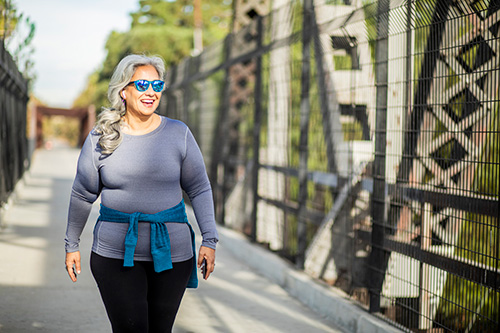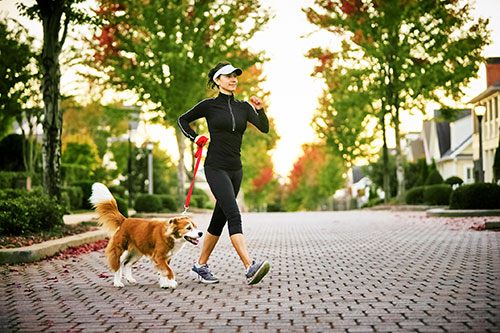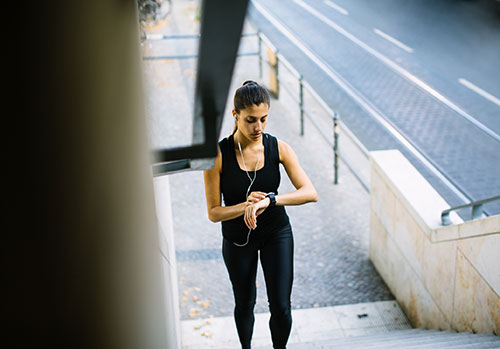By Sherri Young, RN, Nurse-Educator
If you enjoy walking for exercise but want to supercharge the benefits, consider transforming your walks into workouts. You’ll be amazed at how easy it is.

We love walking workouts because you can customize them to your current level of fitness, and then add intensity from there. A few walking upgrades speed up the rate at which you build stamina, muscle tone, bone density and aerobic fitness. Plus, walking workouts help your body steadily shed belly fat so they’re great for weight loss.
Walking is good exercise because it’s convenient, enjoyable, free and you don’t need any special equipment. With just a few tweaks, you can turn your favorite regular neighborhood walks into genuine fitness sessions.
Walking workout basics
While beginning walkers aim for at least 10,000 steps a day — enough for heart health and weight maintenance — you need to add another 5,000–10,000 steps (or more) to hit workout level. You should also make your route challenging by adding some hills, long inclines or even outdoor stairs when you can find them (parks, stadiums, etc.). Some people like to use ankle or hand weights too.
To hit workout intensity, do most of your workout-walking at the same time, rather than adding up all your steps throughout the day. Like other workouts, you want to steadily push harder and walk longer distances.
To get started, choose a walking workout that fits your style, or try several and alternate between them. Allow yourself a few days to get used to each new routine and then focus on mastering it.
1. Walking workout with deep breathing
Add deep breathing to your walking technique to boost oxygen intake and engage the small blood vessels in the lower lungs. When you breathe better, your heart pushes out more oxygenated blood to the muscles that are doing the work. Deep breathing adds more exercise intensity than you might think. You may slip back into shallow-breathing, but that’s normal. Just start deep-breathing again and soon, you’ll be doing it for most of the walk.
How to do it: Straighten your posture and notice your breathing. Focus on taking complete breaths. Inhale fully through your nose — about 4 seconds — and fill your belly, letting your ribcage expand. Let your shoulders and collarbones draw back so the front of your body gently opens up. Then exhale for 4 seconds, letting out the air at the top of your lungs first. Pull in your ribs and pull the belly button toward the spine until you’re out of air. Repeat.

2. Walking workout with shortened stride and arm motion
You might think that longer steps are the best way to go faster but overstriding can quickly lead to injuries. Instead, adapt your stride to a shorter forward step, and then add the correct arm motion to walk faster and raise your heart rate without hurting yourself.
How to do it: Your back foot is the one pushing you forward so practice keeping it on the ground longer. Let your front foot come down closer to your body, instead of way out in front. With your elbows at 90 degrees, let your arms move naturally — one arm forward while the foot on the opposite side goes back. Keep your arms close to your body and practice moving your hands further back, like you’re reaching for your back pocket. These two movements take practice but become much more natural as your pace increases.

3. Walking workout with tempo-based strides
Moving to a steady beat makes working out less tiring and more interesting. If you listen to music while you walk, you know how fun it is when your feet hit the ground in time with the beat. But when the song changes, you can lose that momentum. Put app-based technology to work for you so you can match each step to a beat for a steadier pace, better form and a more intense workout.
How to do it: You’ll need either a smartphone (or smartwatch) or a portable metronome. One phone app we like, ROCKMYRUN, streams music that matches the pace of your walking, or delivers tunes that encourage you to go a little faster. It helps you figure out your walking rate — and it’s free. But there are lots of others to choose from, and the cost is usually very low. Or you can try a portable metronome (available online and at music stores) to improve your walking stride and make it easier to keep pace without having to think about it. Clip-on metronomes cost as little as $10.00. Just choose your pace, set the metronome and you’re off.
Walking workouts are the way to go
We love these workouts because they offer so many options to improve fitness while we’re doing something we already love: walking. It does take a few sessions to get used to these new techniques but you will be amazed at how quickly your stamina and endurance improve.
Experiment with distances and routes so you’ll have several walking workouts to choose from. Then you’ll have the variety you need to take care of your body from day to day, along with the flexibility to accommodate your schedule.












